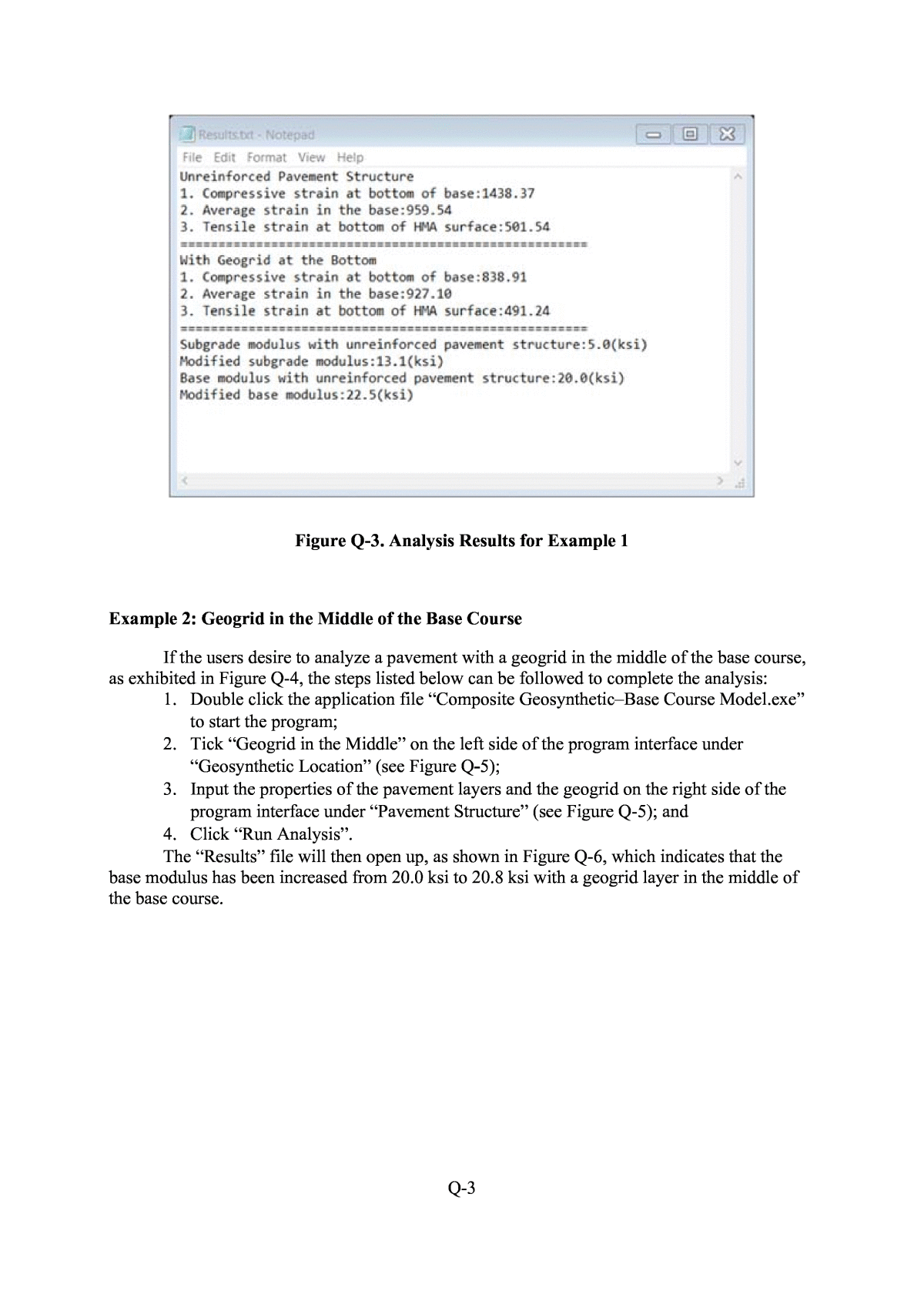








Below is the uncorrected machine-read text of this chapter, intended to provide our own search engines and external engines with highly rich, chapter-representative searchable text of each book. Because it is UNCORRECTED material, please consider the following text as a useful but insufficient proxy for the authoritative book pages.
Q-1 APPENDIX Q. EXAMPLES OF PROGRAM RUNS OF THE COMPOSITE GEOSYNTHETICâBASE COURSE MODEL Four examples are presented in this appendix to illustrate using the program named âComposite GeosyntheticâBase Course Modelâ to analyze the pavement structure with/without geogrid or geotextile within the base course. The model analysis provides the following results: 1. Critical strains in the unreinforced pavement structure, including: a. Compressive strain at the bottom of the base course; b. Average strain in the base course; c. Tensile strain at the bottom of the asphalt layer; 2. Critical strains in the pavement with a geosynthetic layer, including: a. Compressive strain at the bottom of the base course; b. Average strain in the base course; c. Tensile strain at the bottom of the asphalt layer; 3. Modified moduli of the base and the subgrade with the geosynthetic reinforcement that are equivalent to those of an unreinforced pavement. Example 1: Geogrid at the Bottom of the Base Course If the users would like to analyze a pavement structure reinforced using the geogrid at the bottom of the base course, as illustrated in Figure Q-1, they may take the following steps to perform the analysis: 1. Double click the application file âComposite GeosyntheticâBase Course Model.exeâ to start the program; 2. Tick âGeogrid at the Bottomâ on the left side of the program interface under âGeosynthetic Locationâ (see Figure Q-2); 3. Input the properties of the pavement layers and the geogrid on the right side of the program interface under âPavement Structureâ (see Figure Q-2); and 4. Click âRun Analysisâ. The âResultsâ window will then pop up, as shown in Figure Q-3. It can be observed from Figure Q-3 that the subgrade modulus has been increased from 5.0 ksi to 13.1 ksi and base modulus has been increased from 20.0 ksi to 22.5 ksi with placing the geogrid at the bottom of the base course.
Q-2 Figure Q-1. Placing Geogrid at the Bottom of Base Course Figure Q-2. Select âGeogrid at the Bottomâ and Input Material Properties
Q-3 Figure Q-3. Analysis Results for Example 1 Example 2: Geogrid in the Middle of the Base Course If the users desire to analyze a pavement with a geogrid in the middle of the base course, as exhibited in Figure Q-4, the steps listed below can be followed to complete the analysis: 1. Double click the application file âComposite GeosyntheticâBase Course Model.exeâ to start the program; 2. Tick âGeogrid in the Middleâ on the left side of the program interface under âGeosynthetic Locationâ (see Figure Q-5); 3. Input the properties of the pavement layers and the geogrid on the right side of the program interface under âPavement Structureâ (see Figure Q-5); and 4. Click âRun Analysisâ. The âResultsâ file will then open up, as shown in Figure Q-6, which indicates that the base modulus has been increased from 20.0 ksi to 20.8 ksi with a geogrid layer in the middle of the base course.
Q-4 Figure Q-4. Placing Geogrid in the Middle of Base Course Figure Q-5. Select âGeogrid in the Middleâ and Input Material Properties
Q-5 Figure Q-6. Analysis Results for Example 2 Example 3: Geotextile at the Bottom of the Base Course If a geotextile layer is used at the bottom of the base course, as displayed in Figure Q-7, the users may take the following steps to analyze the pavement structure: 1. Double click the application file âComposite GeosyntheticâBase Course Model.exeâ to start the program; 2. Tick âGeotextile at the Bottomâ on the left side of the program interface under âGeosynthetic Locationâ (see Figure Q-8); 3. Input the properties of the pavement layers and the geotextile on the right side of the program interface under âPavement Structureâ (see Figure Q-8); and 4. Click âRun Analysisâ. As can been seen from the âResultsâ file (see Figure Q-9), the subgrade modulus has been increased from 5.0 ksi to 7.7 ksi when placing the geotextile layer at the bottom of the base course.
Q-6 Figure Q-7. Placing Geotextile at the Bottom of Base Course Figure Q-8. Select âGeotextile at the Bottomâ and Input Material Properties
Q-7 Figure Q-9. Analysis Results for Example 3 Example 4: Geotextile in the Middle of the Base Course The last example is the pavement structure with a geotextile layer placed in the middle of the base course, as shown in Figure Q-10. The following steps may be taken to analyze this pavement structure: 1. Double click the application file âComposite GeosyntheticâBase Course Model.exeâ to start the program; 2. Tick âGeotextile in the Middleâ on the left side of the program interface under âGeosynthetic Locationâ (see Figure Q-11); 3. Input the properties of the pavement layers and the geotextile on the right side of the program interface under âPavement Structureâ (see Figure Q-11); and 4. Click âRun Analysisâ. As shown in Figure Q-12, the âResultsâ file indicates that placing a geotextile layer in the middle of the base course in fact decreases the modulus of the base course from 40.0 ksi to 26.2 ksi.
Q-8 Figure Q-10. Placing Geotextile in the Middle of Base Course Figure Q-11. Select âGeotextile in the Middleâ and Input Material Properties
Q-9 Figure Q-12. Analysis Results for Example 4
